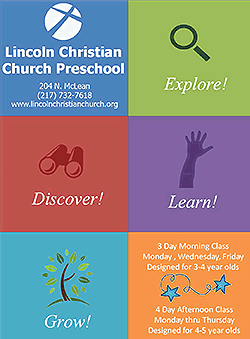|
 When looking into financing a college education, it is good to
look at many different options besides taking out student loans that
may leave the student in debt for many years. When looking into financing a college education, it is good to
look at many different options besides taking out student loans that
may leave the student in debt for many years.
Director of Financial Aid at Lincoln Christian University Nancy
Siddens says, "It is true that the cost of higher education has
risen at a higher percentage than the cost of living over the last
decade, but don't let the 'sticker price' alarm you as there are
grants, scholarships, student loans, and savings plans that will
reduce the cost that a family has to pay when a student starts
college."
Jack Getchel, who worked in the financial office at Lincoln
Christian University for many years, said it is better to try to
avoid taking out student loans when possible.
Getchel said it is also important to know the difference between
subsidized and unsubsidized loans. With the subsidized loan, the
federal government pays the interest while the student is in college
or when the loan is deferred. With an unsubsidized loan, interest
starts accruing as soon as the loan is taken out.
When considering savings plans for college, note that it can take
many years to save up the amount needed for college.
 Siddens says, "If your children are young, I recommend looking into
a college savings plan, such as the College Illinois 529 prepaid
tuition program. They have options for attending a community college
or a university. At any age, you can become a member of Upromise,
where you earn cash back for college by buying groceries, eating
out, and shopping."
Mark Kantrowitz of Money magazine says a 529 savings plan can help
you save for at least a portion of the costs. Kantrowitz says, "If
you can manage it, aim for saving enough to cover at least one-third
of future college costs. For a child born this year, that means
saving $250 a month from birth for future enrollment in a public
four-year college."
The college savings plan is a good idea, but not always feasible.
Getchel says many do not think about saving until their kids are in
high school.
It is also important to realize there are fees associated with these
plans and any money withdrawn from the plan and not used for
education expenses will have a tax penalty.
For those who have not been able to save, there are many
scholarships you can apply for.
Siddens says, "If your child is in high school, start looking for
scholarships. Contact the financial aid office at the colleges you
are interested in attending to see what they have available." She
says "Most of the area high schools have a list of scholarships.
Check with your employer. If you are a religion major, even the
church that you attend might have scholarships."
Siddens also says, "There are online scholarship sites where you can
enter your personal information and they will email you scholarships
that are available. One reputable site is fastweb.com." Fast web
offers information on scholarships, financial aid, student loans and
more.
Bridget Schneider, a Certified Financial Planner with Level Four
Wealth Management in Lincoln has talked to many people about saving
for college education. Schneider says, savingforcollege.com is a
good website she has directed many people to. The site has links to
529 plans, college savings 101, college planning, and some financial
aid basics on both self-help and gift aid.
[to top of second column] |

Schneider says, "Financial planning and starting early is important.
It is good to work with a professional on creating a financial plan
for short and long-term goals. It will help you have a clearer
picture of where you are going and how you will get there. Working
with a Certified Financial Planner professional can give you peace
of mind."
Schneider also says, "If you have goals for saving for your child's
college education, working with a financial planner may be helpful."
Schneider says not all scholarships are based on academic
performance, but it requires a lot of work to find these
scholarships. They might have some unique requirements, so Schneider
says to start early in looking into these scholarships.
Filling out a financial aid application is important for those who
are getting ready to enter college.
Siddens says, "Every student attending college will want to complete
the Free Application for Federal Student Aid which will determine
their eligibility for federal and state grants. The FAFSA can be
completed as early as October 1 for the next academic year. For
example, if a student will begin college in August 2018, complete
the FAFSA as early as October 1, 2017."
Completing the FAFSA will be helpful for knowing your options for
financing your college education and for how much aid you may be
eligible.
As Siddens says, "Don't assume that going to college will be too
expensive for your family. Check out all your options."

 |